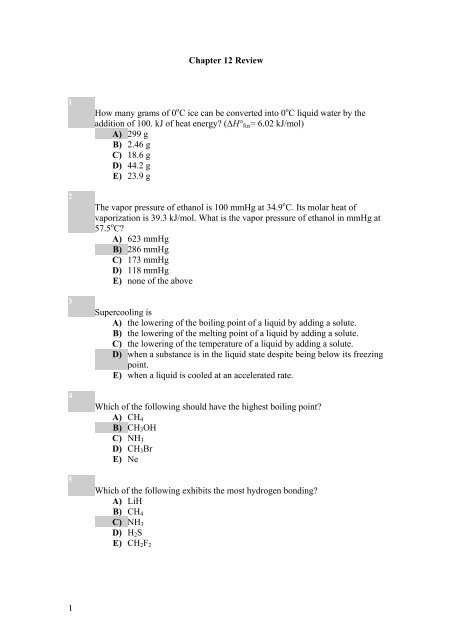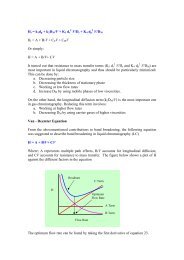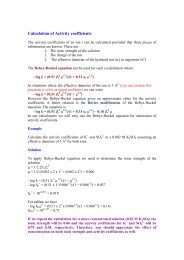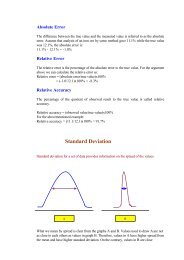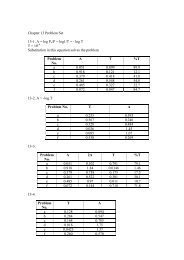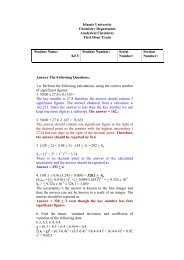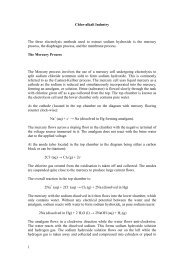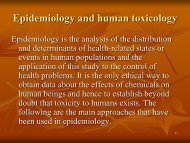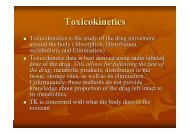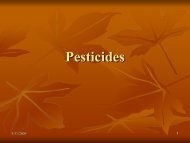1 Chapter 12 Review How many grams of 0oC ice can be converted ...
1 Chapter 12 Review How many grams of 0oC ice can be converted ...
1 Chapter 12 Review How many grams of 0oC ice can be converted ...
Create successful ePaper yourself
Turn your PDF publications into a flip-book with our unique Google optimized e-Paper software.
<strong>Chapter</strong> <strong>12</strong> <strong>Review</strong><br />
1<br />
2<br />
3<br />
4<br />
5<br />
<strong>How</strong> <strong>many</strong> <strong>grams</strong> <strong>of</strong> 0 o C <strong>ice</strong> <strong>can</strong> <strong>be</strong> <strong>converted</strong> into 0 o C liquid water by the<br />
addition <strong>of</strong> 100. kJ <strong>of</strong> heat energy? (ΔH° fus = 6.02 kJ/mol)<br />
A) 299 g<br />
B) 2.46 g<br />
C) 18.6 g<br />
D) 44.2 g<br />
E) 23.9 g<br />
The vapor pressure <strong>of</strong> ethanol is 100 mmHg at 34.9 o C. Its molar heat <strong>of</strong><br />
vaporization is 39.3 kJ/mol. What is the vapor pressure <strong>of</strong> ethanol in mmHg at<br />
57.5 o C?<br />
A) 623 mmHg<br />
B) 286 mmHg<br />
C) 173 mmHg<br />
D) 118 mmHg<br />
E) none <strong>of</strong> the above<br />
Supercooling is<br />
A) the lowering <strong>of</strong> the boiling point <strong>of</strong> a liquid by adding a solute.<br />
B) the lowering <strong>of</strong> the melting point <strong>of</strong> a liquid by adding a solute.<br />
C) the lowering <strong>of</strong> the temperature <strong>of</strong> a liquid by adding a solute.<br />
D) when a substance is in the liquid state despite <strong>be</strong>ing <strong>be</strong>low its freezing<br />
point.<br />
E) when a liquid is cooled at an accelerated rate.<br />
Which <strong>of</strong> the following should have the highest boiling point?<br />
A) CH 4<br />
B) CH 3 OH<br />
C) NH 3<br />
D) CH 3 Br<br />
E) Ne<br />
Which <strong>of</strong> the following exhibits the most hydrogen bonding?<br />
A) LiH<br />
B) CH 4<br />
C) NH 3<br />
D) H 2 S<br />
E) CH 2 F 2<br />
1
6<br />
7<br />
8<br />
9<br />
10<br />
11<br />
Formaldehyde (OCH 2 ) <strong>can</strong> hydrogen bond with water. What is the maximum<br />
num<strong>be</strong>r <strong>of</strong> hydrogen bonds in which a single formaldehyde molecule <strong>can</strong><br />
participate?<br />
A) 2<br />
B) 3<br />
C) 4<br />
D) 5<br />
E) 6<br />
Which <strong>of</strong> the following carbon compounds has the highest melting point?<br />
A) CF 4<br />
B) CCl 4<br />
C) CBr 4<br />
D) CI 4<br />
E) CH 4<br />
Which <strong>of</strong> the following liquids would have the highest viscosity at a particular<br />
temperature?<br />
A) CH 2 Br 2<br />
B) C 2 H 5 OH<br />
C) CH 3 Cl<br />
D) HOCH 2 CH 2 OH<br />
E) CH 3 OCH 3<br />
Water has such a high specific heat <strong>be</strong>cause<br />
A) it has such a low molecular weight.<br />
B) it is rather dense.<br />
C) the O-H single bond has a high bond energy.<br />
D) it has <strong>many</strong> relatively strong hydrogen bonds.<br />
E) it dissolves both ionic and covalent compounds.<br />
In a structure with a cubic unit cell, how <strong>many</strong> unit cells "share" each corner<br />
atom <strong>of</strong> the cu<strong>be</strong>?<br />
A) 10<br />
B) 8<br />
C) 6<br />
D) 4<br />
E) 2<br />
Calculate the volume effectively occupied by a single CsCl ion pair in the<br />
crystal given that the density <strong>of</strong> crystalline CsCl is 3.988 g/cm 3 .<br />
A) 0.251 cm 3<br />
B) 7.01 × 10 -23 cm 3<br />
C) 3.93 × 10 -26 cm 3<br />
D) 42.2 cm 3<br />
E) none <strong>of</strong> the above<br />
2
<strong>12</strong><br />
Vanadium crystallizes in a body-centered cubic latt<strong>ice</strong>. What is the num<strong>be</strong>r <strong>of</strong><br />
nearest neighbors (atoms that make contact) around each atom in this latt<strong>ice</strong>?<br />
A) 2<br />
B) 4<br />
C) 6<br />
D) 8<br />
E) It depends on whether the atom is a corner atom or a central atom.<br />
13<br />
In SiO 2<br />
A) the valence band is the same as the conduction band.<br />
B) the two bands are filled with electrons.<br />
C) the valence band and the conduction band are separated by a large<br />
energy gap.<br />
D) the strong Si-O bond prevents the flow <strong>of</strong> electrons.<br />
E) double bonds <strong>be</strong>tween Si and O are responsible for making it a<br />
semiconductor.<br />
14<br />
15<br />
16<br />
Which <strong>of</strong> the following has the greatest electrical conductivity?<br />
A) Cu<br />
B) Fe<br />
C) Pure Ge<br />
D) Ge doped with In<br />
E) Al 2 O 3<br />
Acetic acid has a heat <strong>of</strong> fusion <strong>of</strong> 10.8 kJ/mol and a heat <strong>of</strong> vaporization <strong>of</strong><br />
24.3 kJ/mol. Estimate the value for the heat <strong>of</strong> sublimation.<br />
A) 35.1 kJ/mol<br />
B) 13.5 kJ/mol<br />
C) -13.5 kJ/mol<br />
D) -35.1 kJ/mol<br />
E) none <strong>of</strong> the above<br />
Use the Clausius-Clapeyron equation to estimate the boiling point <strong>of</strong> water at<br />
24.0 torr pressure.<br />
(ΔH vap = 42.30 kJ/mol)<br />
A) 33.2 °C<br />
B) 110 °C<br />
C) 25 °C<br />
D) 80 °C<br />
E) 52.9 °C<br />
3
17<br />
18<br />
19<br />
20<br />
21<br />
The triple point is<br />
A) an end to the liquid-gas line in a phase diagram.<br />
B) the relationship <strong>be</strong>tween the boiling point, melting point and vapor<br />
pressure <strong>of</strong> a substance.<br />
C) the point on a phase diagram where solid, liquid, and gas are in<br />
equilibrium.<br />
D) the three pieces <strong>of</strong> data needed to solve the Clausius-Clapeyron<br />
equation.<br />
E) the (P,V,T) coordinate <strong>of</strong> a point on a phase diagram.<br />
The main forces responsible for the structure <strong>of</strong> DNA are<br />
A) ionic bonds and covalent bonds.<br />
B) covalent bonds and ionic bonds.<br />
C) hydrogen bonds and dipole-dipole interactions.<br />
D) covalent bonds and hydrogen bonds.<br />
E) covalent bonds and dipole-dipole interactions.<br />
Which <strong>of</strong> the following is not likely to exhibit hydrogen bonding?<br />
A) CH 3 CH 2 OH<br />
B) CH 3 NH 2<br />
C) H 2 O<br />
D) NH 2 OH<br />
E) (CH 3 ) 3 N<br />
Methylamine (CH 3 NH 2 ) <strong>can</strong> hydrogen bond with water. What is the maximum<br />
num<strong>be</strong>r <strong>of</strong> hydrogen bonds in which a single methylamine molecule <strong>can</strong><br />
participate?<br />
A) 2<br />
B) 3<br />
C) 4<br />
D) 5<br />
E) 6<br />
In which <strong>of</strong> the following molecules are dispersion forces likely to <strong>be</strong> the most<br />
important in determining the melting and boiling points?<br />
A) H 2 S<br />
B) CO<br />
C) HCl<br />
D) ICl<br />
E) Br 2<br />
4
22<br />
23<br />
Which <strong>of</strong> the following liquids would have the highest viscosity at a given<br />
temperature?<br />
A) C 2 H 5 OC 2 H 5<br />
B) CH 3 CH 2 Cl<br />
C) CH 3 CH 2 COOH<br />
D) CH 3 COOCH 3<br />
E) C 2 H 5 OH<br />
Place the following in order from the least to most soluble in water:<br />
1. HOCH 2 CH 2 CH 2 OH<br />
2. CH 3 CH 2 CH 2 CH 3<br />
3. HOCH 2 C(OH)HC(OH)HCH 2 OH<br />
A) 1


